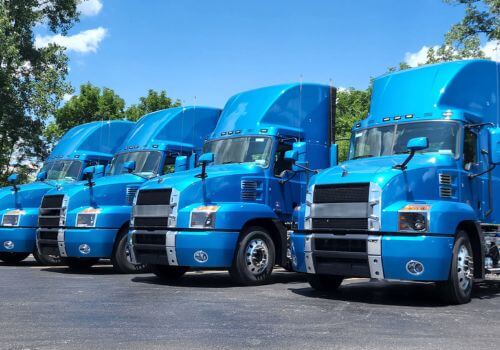Becoming a truck driver can be both an exciting and financially rewarding career, with a good salary, incredible travel opportunities, and employee benefits. If you want to drive a truck, you have to acquire a CDL license. The training program may be expensive, but it will allow you to make up for the expenses later. In addition, CDL training courses will give you information on various career options. Similarly, tuition reimbursement programs will help you to pay for the training.
Transportation being the backbone of all modern industries, the success of local economies is highly dependent upon a thriving trucking sector, which requires over 400,000 new drivers every year. Since the demand for drivers is huge and continues to grow, you can take advantage of this trend by obtaining a CDL Class A truck driver license and joining tuition reimbursement programs.
Medical Requirements
Commercial drivers and truckers are the lifeblood of the US economy. In fact, trucks move 70% of the freight across the country. If you want to become a professional trucker, obtaining a Class A truck driver’s license will prove to be a rewarding opportunity. However, there are certain medical criteria that you must fulfill.
Whether you’re interested in moving around the country or are driving large trucks for a living, there are certain endorsements that you will need to be able to operate heavy vehicles across the country. The first and foremost requirement is that you must have a CDL license. Besides a CDL, you need to hold a valid certificate from a medical examiner. It’s important to note that there are additional requirements for drivers of commercial motor vehicles that are not listed here. These requirements can vary by state.
Training for truck driving can take as little as two weeks or a year. Some training programs even offer job placement. Upton completion of the course, students are placed by trucking companies. However, make sure you choose a reputable school if you are unsure about the company. Not all trucking companies offer job placement programs, so it is important to do some research before deciding on a school.
Another important requirement for CDL drivers is hearing. You need to have adequate hearing to identify vehicles in momentary blind spots and to understand the safety warnings that are posted in urban areas. The test for hearing requires a driver to hear a “forced whisper” at a distance of five feet. Hearing aids are allowed to help meet this requirement. Once you’ve completed the medical examination, you’ll need to pass a written exam.
The medical requirements for CDL drivers differ by state. In NY, for example, commercial drivers must choose a single state to conduct their operation. However, the federal medical requirements are the same for all commercial drivers. The only difference is that if you’re a veteran, you must have proof of relevant military experience. If you’re a veteran, you can also waive the CDL written and driving tests.
Physical Requirements
As a truck driver, you will face long hours of physical labor, so you need to make sure your body and physical health are in peak condition. DOT physicals will test your eyesight, ears, and general well-being. You’ll also be required to lift 50 pounds, drive a heavy truck, and sit for long periods. It’s best to train as hard as you possibly can to meet these requirements.
Depending on where you live, training programs can take anywhere from a couple of weeks to several months. You can enroll in a company-sponsored training program that lasts from two to four weeks, or you can choose a private CDL school. Community college training programs can take anywhere from four to six months. Once you’ve completed your training, you must take an exam in a combination vehicle.
You must also pass a DOT physical as a driver to obtain a commercial license. The physical must be conducted by a certified physician on the FMCSA National Registry of Certified Medical Examiners. The DOT physical tests check blood pressure, eyesight, hearing, glucose levels, and more. The test is a thorough screening of your overall health, and any deficiencies in those areas can keep your CDL from being approved.
Other requirements are more general in nature. To become a truck driver, you must be at least 18 years old. Once you are 21 years old, you can operate outside your state’s borders. There are also physical requirements you’ll need to fulfill. A DOT medical card and a physical from an examiner listed on the national registry are also essential. You’ll also need to pass an exam on CDL physicals.
To obtain a CDL Class A License, you have to successfully complete all the previous steps. After passing the written exam, you’ll have to pass a driving skills test. You may have to take additional endorsement exams if you want to drive triple or double trailers. Additionally, air brakes are an important requirement for all Class A truck drivers. So, if you have the necessary qualifications, truck driving may be the perfect career for you!
The Cost of Training
To become a professional truck driver, you need to have a Class A CDL, or commercial driver’s license. Class A CDL holders are able to drive interstate and have all the necessary licenses and certifications required.
They must be able to pass the CDL exam to operate a commercial truck. Class B CDL holders are able to operate a single vehicle with cargo or a trailer, but not a trailer. These drivers need at least 80 hours of training to qualify for Class B CDL status. Typically, the course is two weeks long; however, the course for Class A CDLs can take up to 4 weeks.
Although many paid CDL training programs offer tuition-free plans, they usually require students to pay back tuition costs upon completion of the program. In order to get a CDL, you need to meet the age requirements of the company you’re applying to, which can vary by state. You will need a minimum of two years of experience in the trucking industry to become a successful trucker.
Free CDL training may be an attractive option, but it’s not for everyone. You’ll need to uphold a legal agreement with your carrier. If you opt for a paid training program, you should be aware of all the fees and costs associated with it. Then, you can make a decision based on your financial circumstances. We recommend going for the option which will give you more control over your future career.
The cost of CDL licensing differs by state. Some require you to take a physical exam and perform a urinalysis, which adds to the cost. Also, the cost of the license or permit can differ by state. Ultimately, your education is more important that its price. Whether you are looking for a low-cost or high-quality program, it is important to research every option thoroughly before you make a decision.
The cost of CDL training varies greatly from state to state and from provider to provider. The amount of money spent may differ in different training schools, but most programs last for between four to six weeks and provide all the training you need to get your license. You will also need to get a license if you want to drive a commercial truck. The average cost of CDL training for a Class A truck driver is between $3,000 and $7,000.
Requirements for a Commercial Driver's License
A CDL Class A truck driver’s license is required for professional drivers who operate large commercial vehicles. Class A truck drivers are often responsible for carrying specific payloads and may drive long hours.
Before they can obtain a CDL, they must have completed 160 hours of classroom instruction and at least 20 hours of wheel training. To become a Class A driver, you will need to complete a truck driving course, which will also involve classroom work and on-the-road wheel training.
The classroom training is almost as important as the driving time. The program typically lasts 300 hours and includes onsite training and maneuvering practice on public roads. Students must have a learner’s permit for at least two weeks before they can take their final test. Most schools will arrange appointment times and vehicles. Moreover, they’ll make sure students have access to the right vehicle for the tests.
Commercial drivers must possess a Medical Examiner’s Certificate if they plan to drive a vehicle in interstate commerce. CDL holders in New York, for example, must present a copy of their ME Certificate to the SDLA. Similarly, Interstate excepted drivers must meet Federal DOT medical card requirements. If you have a physical impairment, you may be required to take a skill performance evaluation (SPE).
To drive a commercial vehicle, you must be at least 21 years old. For an out-of-state license, you must be at least 18 years old. For an interstate license, you must be at least 21 years old. Moreover, you must be legally present in the United States, unless you’re a US citizen. In addition, you must have a medical exam by an authorized medical examiner listed on the National Medical Registry.
While it is a good idea to attend a truck driver training course before applying for a CDL, it is essential that you have the right knowledge to pass the exam. It is possible to take the exam without formal training and you can do so through a commercial leaner’s permit. If you decide to apply for a CDL, you should first visit your local DMV office to complete an application and undergo a skills test.
What are a CDL Class A Truck Driver's Responsibilities?
Here are some examples of responsibilities expected from a CDL Class A driver collected from the Curriculum Vitae of actual drivers that illustrate the kind of duties they are likely to accomplish:
- Handle technical upkeep of the bus/truck, manage on CDL, license board transceivers proficiently, and react properly to escalated problems and emergencies.
- Carry commodities and industrial equipment, such as crushed automobiles, and metal products – often made of aluminum, copper, steel, and wood.
- Operate a refrigerated (reefer) flat truck and be responsible for delivering all items within the required delivery window.
- Assist in keeping the job site clean and checking vehicles every day following CDL standards.
- Have a thorough understanding of HAZMAT transport and delivery procedures and processes.
- Be in charge of bringing wood floors to job sites and picking them up.
- Know enough about used day cabs, full bed tractors, dry van trailers, and reefer trailers
- Plan travel routes based on traffic rules, norms, and restrictions, as well as those for moving large amounts of freight.
- Keeping and securing dot records of each travel.
- Know how to use GPS and maps well enough to plan delivery routes that save both time and money.
- Use objects like laptops, radios, phones, and global positioning system (GPS) devices.
- Transport hazardous materials in accordance with all institutional and OSHA regulations.
- Coordinate daily collection and delivery appointments with dispatch
The need for adhering to and implementing quality assurance guidelines and OSHA regulations to satisfy work requirements has never been greater in this position. It facilitates interdepartmental collaboration to deliver better customer service. This is to ensure that your performance is up to mark and that you undertake regular documentation pre-checks using a business checklist and submit thorough trip and delivery reports. This is not a stand-alone activity, but undertaking detailed daily pre-trip checks and maintaining complete documentation aids mechanics in reducing overhead running expenses via preventative maintenance.
Steps to Becoming a CDL Class A Truck Driver
1. Get a standard driver's License
Firstly, you should pass the Government’s Standard Driver’s Licensing Exam. Prior to obtaining a CDL in your jurisdiction, you need to possess a valid driving permit. You may well be ready to start working in your job driving delivery vehicles with a standard license while training for a CDL. The cost of a U.S. driver’s license ranges from $20 to $90 USD.
2. Earn a high school diploma or GED
According to the U.S. Bureau of Labor Statistics (BLS), the majority of long-haul firms require candidates to possess a high school certificate or GED. In the majority of states, you can acquire your GED within four months for a cost of $80 to $140.
3. Start your professional training
Community universities, independent commercial truck academies, and trucking firms provide tractor driver’s education courses that prepare participants for the CDL examination. Several jurisdictions have their very own audit and accreditation procedures, so be sure to familiarize yourself with your county’s BMV or DMV laws. Different seminars for driver instruction sometimes run up to one year. Costs for specialized schools and public community colleges might vary between $1,000 and $10,000.
State universities also offer financial help to tractor-operating program students. Some might provide an associate’s degree in trucking or industrial logistic administration. This is not required to receive a driver’s license, but it is an excellent choice if you wish to finish college.
Typically, corporation-sponsored programs run for six weeks and are priced at around $6,000. Most provide discounts, funding alternatives, and in certain cases, complete repayment to grads who remain with the organization for a certain period of time.
4. Get your CDL and necessary accolades
The minimum prerequisite for CDL is applying for and passing A, B, and C classes, depending on the quality and tonnage of the vehicle. The CDL-A is by far the most flexible certification for heavy freight drivers.
You may also require an approval number on your driving license. Accolades identify what you have been lawfully permitted to carry and are required for using specialized vehicles such as public buses and lorries. FMCSA describes the various classifications and certification codes. However, you should also check your state’s BMV or DMV.
In several states’ BMV or DMV systems, there is a price for the CDL registration, examination, and licensure. The licensing price will be in a higher range here, ranging between $20 and $120.
5. Get job-placement support
Several commercial truck schools include professional guidance and employment agencies. Unions for truck drivers also link participants with hiring companies and mentors. Among these organizations are the ATA (American Trucking Associations) and Women in Trucking, among others.
6. Complete the company's graudation program
The majority of organizations need newly-licensed personnel to take in-house training and instruction. These training courses, also known as driver completion programs, expose employees to the firm’s trucks, supplies, and technology. The training may run between three and four weeks and include supervised driving.
Additional Tips for CDL Drivers
Gain a reputation for being safe and reliable
It is essential to have a clean driving record, particularly at the beginning of your driving career. Driving recklessly might result in the loss of your CDL. Additionally, make an effort to create a reputation of dependability with your company and clients. Developing solid connections early in your work may assist you in securing your next position or more desired career paths, promotions, and better opportunities later.
Acquire specialized expertise
Occasionally, businesses must carry extra-wide goods or dangerous commodities. In these situations, firms seek essential recommendations and verified expertise.
Conclusions
As a qualified truck driver, you can seek bright job opportunities in every single industry and profession. Truck drivers not only enjoy personal freedom while working, but they also have more job security, attractive salaries, insurance, and medical coverage. The key takeaways are shift flexibility, high entry-level pay, company support, and oftentimes, paid vacations. However, with these perks come great responsibility, and you must obtain the needed licensure to qualify.











